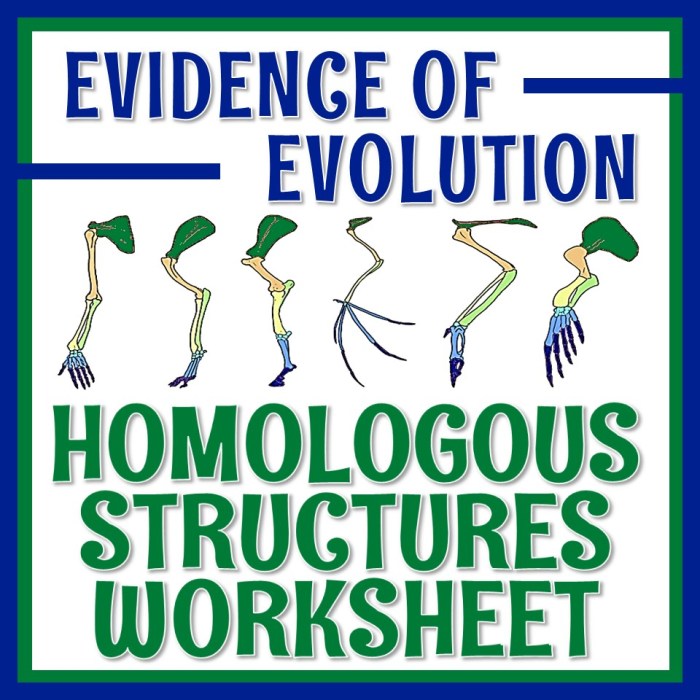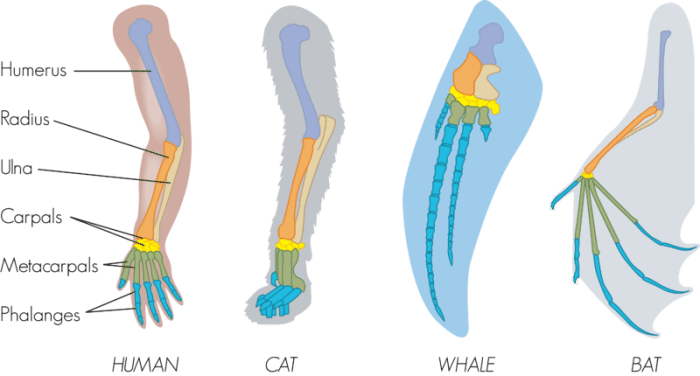Embark on an academic exploration with our homologous analogous and vestigial structures worksheet answer key. This definitive resource unravels the intricacies of these biological concepts, providing a comprehensive understanding of their evolutionary significance and the captivating tales they tell about the history of life on Earth.
Delve into the fascinating realm of homologous structures, uncovering their shared ancestry through striking similarities. Discover the remarkable diversity of analogous structures, shaped by convergent evolution to fulfill similar functions despite distinct evolutionary lineages. Unravel the enigmatic vestiges of our evolutionary past through the lens of vestigial structures, remnants of ancestral traits that have lost their original purpose.
Homologous Structures

Homologous structures are anatomical structures that share a common evolutionary origin and may or may not have similar functions. They provide evidence for the theory of evolution and the common ancestry of different organisms.
Examples of homologous structures include:
- The forelimbs of humans, bats, and whales, which have the same basic bone structure despite their different functions (walking, flying, and swimming).
- The wings of birds and bats, which have different shapes and functions but are both modified forelimbs.
- The spines of cacti and the leaves of other plants, which both serve protective functions but have different origins.
Homologous structures support the theory of evolution by demonstrating that different organisms have evolved from a common ancestor and that their structures have adapted to different environments and functions over time.
Analogous Structures

Analogous structures are anatomical structures that have similar functions but different evolutionary origins. They are the result of convergent evolution, where unrelated organisms evolve similar traits in response to similar environmental pressures.
Examples of analogous structures include:
- The wings of birds and insects, which both allow for flight but have different bone structures and origins.
- The eyes of humans and octopuses, which both allow for vision but have different structures and evolutionary origins.
- The fins of fish and the flippers of penguins, which both allow for swimming but have different skeletal structures and origins.
Analogous structures provide evidence for convergent evolution and demonstrate how unrelated organisms can adapt to similar environments and functions.
Vestigial Structures

Vestigial structures are anatomical structures that have lost their original function over time due to evolutionary changes. They are remnants of ancestral structures that were once useful but are no longer necessary for survival.
Examples of vestigial structures include:
- The appendix in humans, which is a small, tube-like organ with no known function.
- The wisdom teeth in humans, which are third molars that are often impacted and have no functional purpose.
- The tailbone in humans, which is a remnant of the tail that was present in our ancestors.
Vestigial structures provide evidence for evolution by showing how organisms can lose traits that are no longer necessary for survival.
FAQ Section: Homologous Analogous And Vestigial Structures Worksheet Answer Key
What are homologous structures?
Homologous structures are anatomical features that share a common evolutionary origin, despite serving different functions in different organisms.
How do analogous structures differ from homologous structures?
Analogous structures have similar functions but do not share a common evolutionary origin, arising from convergent evolution.
What is the significance of vestigial structures?
Vestigial structures provide evidence of evolutionary history, representing remnants of ancestral traits that have lost their original function.

